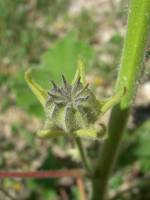|
|
 Fruit Ries Lindley @http://swbiodiversity.org, Usage Rights: Attribution-Non-Commercial (CC BY-NC) | | | | | |
|
Origin:
Native
Life Cycle:
Perennial Similar Species: Abutilon palmeri, Abutilon wrightii
General Desc:
Herbaceous, upright subshrub, woody at the base. Single/multiple long stems, sparsely leaved and coated with soft, woolly, short, downward facing (retrorse) hairs and star-like hair clusters.
Identification notes: Stems erect with downward facing simple and star-like clustered hairs, hairs <1/4 inch long; leaf blades 2-1/2 inches long; flowers solitary, petals to 1/2 inch long, yellowish-orange and without a red center; seeds 3 per ovary, styles 6 to 8 branched.
Height:
To 3-1/4 feet
Habitat Description: Dry areas among rocks and boulders, on the lower slopes and ledges of canyons and hillsides, at the bases of mountains and cliffs.
Plant Communities:
Desert Scrub,
Elevation: 3000 - 3300 feet
Color:
Yellowish-orange
Shape:
Regular not in clusters
Tubular:
N
Flowering Period:
Apr - Aug
Description:
Solitary flowers have 5 petals, to 1/2 inch long emerging from leaf axils (between the leaf and the stem) on very short (up to 3/4 inch) stalks (pedicels). Flowers open only in sunny conditions for a few hours in the late afternoon to evening.
Leaf Color:
Top dark green, whitish below
Leaf Type:
Simple
Leaf Shape:
Triangular
Leaf Margin:
Toothed
Leaf Attachment:
Alternate
Leaves Clasp:
N
Hairs:
Leaves and stems
Spines:
N
Leaf Description:
Oval to triangular to heart-shaped leaves are velvety, 2-1/2 inches long with a distinctly tapered point. Leaves are dark green on top with flat, forked hairs, paler to whitish below with short, soft hairs in star-like clusters.
Fruit Color: Brown
Fruit Notes: Disc-shaped fruit, 3/8 inch long and has 6 to 8 sections each containing 3 seeds. Each section has a spiny tip (spine about 1/16 inch) and a fringe of tiny, star-like, soft hairs along the margin of a lengthwise ridge.
Seed Notes: Seeds are about 1/8 inch and minutely roughened. They do not germinate easily. Older seeds are more likely to germinate than newer. The fruits open and release seeds in June and again after summer rains.
|
|